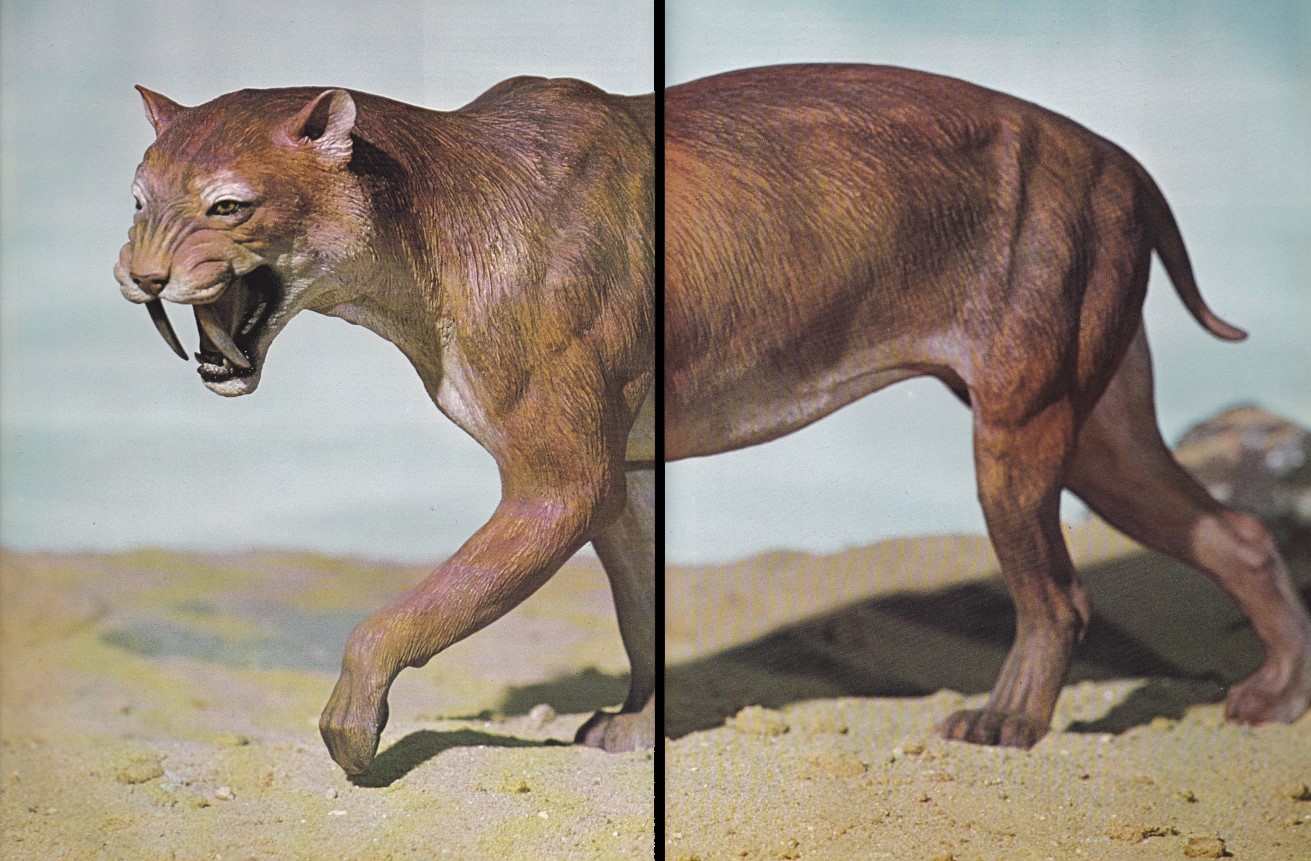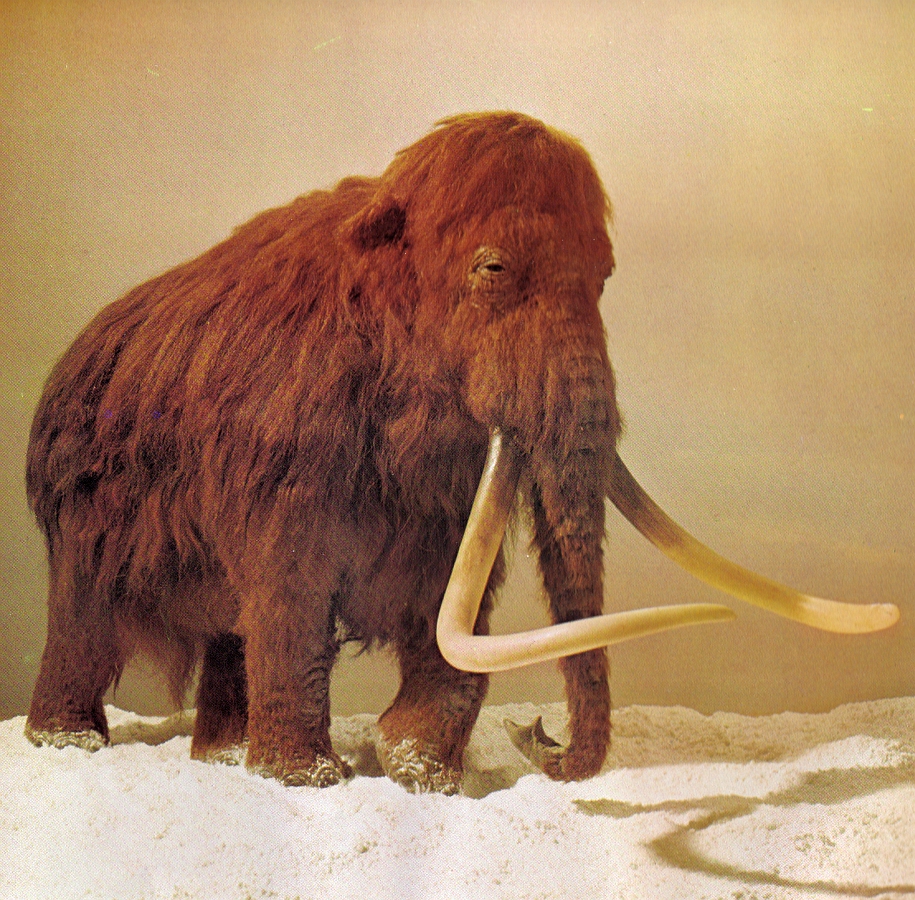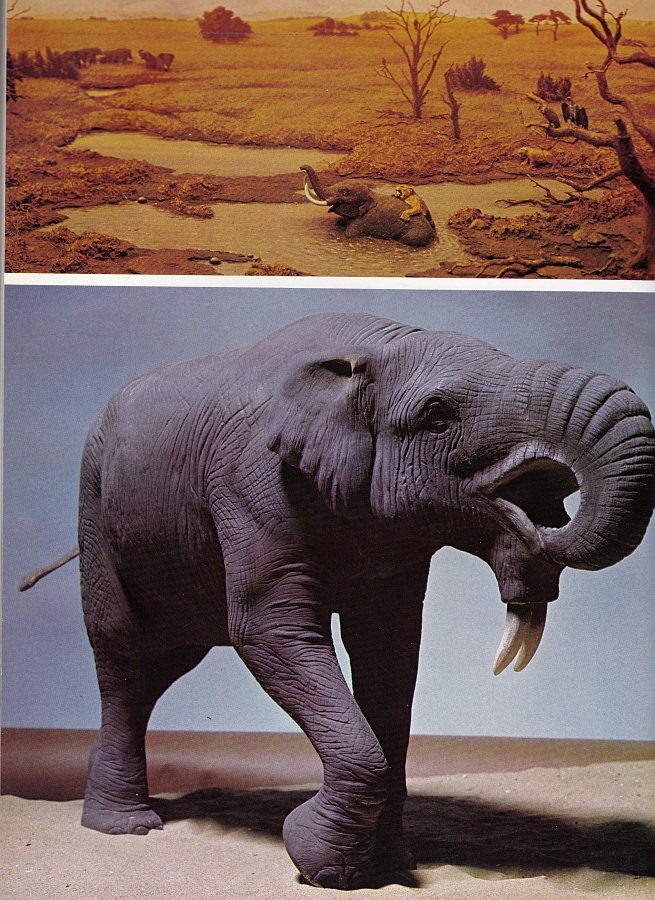By the popular demand of at least a couple of people, let’s have one last look at Prehistoric Animals (see parts one and two for dinosaurs and mostly Palaeozoic non-dinosaurs, respectively). It’s the mammals’ turn! Granted, there are an awful lot of models of fish in here too, which is quite remarkable for a book like this; but they’re fish. Sorry, fish fans. On with those smelly mammals, then.

Most of the models in the Cenozoic section of the book are simply credited to the BM(NH), as it was then so called. A few of them remain on display there to this day, although the above Hyracotherium isn’t, at least as far as I remember. A shame, as this is a lovely diorama that instantly and evocatively makes clear the animal’s small size and lush habitat. It’s the sort of work that immediately fires the imagination. Naturally, the book emphasises the animal’s relationship with modern horses. In fact, Owen seems to be rather a fan of horses, noting:
“The familiar site of the friendly horse is an accepted part of our everyday life. The dignity and courage this noble animal has displayed, from the thoroughbred to the muscular power of the working horse, has been an inspiration to us for many years.”
It all seems a little flowery to me, but then, I’ve never been much into horses. I mean, have you seen one? They’re not just unguligrade, they only have the one hoof on each foot. Weirdos.

One model that has remained on display at the NHM is this Smilodon, proudly displayed alongside a skeletal mount of Smilodon fatalis. It’s an impressive, lifelike sculpt, with suitably bulky musculature and pleasing fine details, like the black rings around the animal’s eyes. The sculptor (G Kinns, whose work also featured in Part 1) appears to have followed the skeletal mount closely, as it’s in a very similar pose, and compliments it very well. The slightly half-hearted empty sandy backdrop does at least mean that the model is firmly centre stage. Nowadays, it stands on a plinth in the skeleton’s case. I do really like the approach of commissioning a scale life reconstruction to stick in the gallery alongside a skeletal mount – it’s something I wish museums would do more often, even if it would mean running the risk of Science Marching On.

G Kinns also sculpted this charming woolly rhino Coelodonta antiquitatis which, again, is highly lifelike. And very hairy. Although the thick pelt is obscuring much of the animal’s shape, it should perhaps have been given a more obvious hump, and I believe it’s thought to have had more of a reddish-brown coat than suggested here; still, the latter can at least be blamed on poor image reproduction. I’m also not sure how old the model is, as although I don’t know all that much these animals (hey, it’s a dinosaur blog), I’m aware that our understanding of them progressed in leaps and bounds in the last century. That’s not to say that this isn’t an impressive model, as it certainly is, as is…

…this woolly mammoth Mammuthus primigenius, by the same artist. This one was certainly on display in the NHM’s mammal gallery very recently, and might still be (please let me know in the comments if you’ve been recently!). I do remember there being a sign describing this model as outdated in some respects, although I’m not sure exactly what they were. To me, it appears to conform with modern reconstructions more closely than the rhino. Some of the fine detailing on this model is gorgeous, especially on the tusks, which look utterly convincing (to the point where I hope they aren’t real ivory!). It was also clearly the inspiration behind the Invicta mammoth toy from their official NHM range, what with that slightly raised left foot that causes the bloody thing to be infuriatingly every-so-slightly off balance and prone to falling over. I blame you, Kinns, and your gorgeous model work.

Back a few tens of millions of years now, for some reason (the images appear in this order in the book), and also back to the work of Arthur Hayward. Unsurprisingly, this Uintatherium looks like it could have walked straight out of a Harryhausen film, in the best possible way. That is to say, although Hayward’s work isn’t as ultra-realistic as Kinns’, it’s still imbued with a great deal of character and a sense of movement that makes every creature believable as a living being. In this case, he also appears to have done a decent job of sticking to what’s known about the animal’s skeletal anatomy.

Hayward was also responsible for this Megaloceros pair (partially chopped off by my scanner – sorry about that), which are given a far more interesting (if slightly faded-looking in this image) backdrop. Naturally, the male is bellowing to the skies as every legendary enormo-antlered stag does, all the time. The mane and overall colouration are clearly based on the extant red deer – countless artists have done this, including greats like Knight and Burian, no doubt following what seemed perfectly sound advice at the time. Of course, as Darren Naish would tell you, just because a particular reconstruction is popular, that doesn’t mean it’s correct; Megaloceros is thought to be more closely related to fallow deer than Cervas (the red deer genus), so the giganto-red-deer or “Monarch of the Glen” meme (as Darren calls it) is rather questionable.
This is still a really lovely model, of course, and the works by Knight and Burian were beautiful, too. But the ways in which the best palaeoart can influence popular and scientific perceptions of particular creatures are always worth examining.

And speaking of impressive palaeoart, I’d love to know where the La Brea tar pit diorama shown above Deinotherium here has ended up. The reddish colour might just be the result of poor reproduction and/or aging, but it really adds to the ominous, oppressive feel of the scene. The use of open space here is rather clever in that it makes the plight of the mammoth seem all the more tragic. It appears to have been abandoned by its herd mates and left for dead, surrounded only by ravenous predators, lurking vultures and endless grassland. I like it a lot.
And below that is a very pleasing sculpture of Deinotherium. Who was the artist? Dunno – these two are just credited to the BM(NH). I have a feeling that the Deinotherium, at least, is still on show along with a series of other proboscid models.

And finally…it’s a fish! In the end, I just couldn’t leave them out. The representation of fish in this book is unusually extensive, and there are a number of photos of quite elaborate dioramas depicting underwater scenes. I was especially taken by the above side-by-side comparison, featuring a fossil and life reconstruction of Pristigenys (both boringly credited to the BM(NH)). Although, based on what I’ve just hastily Googled, I’m not sure if this particular fish would now belong in the extant genus Pseudopriacanthus, instead. Whatever the case, it’s a beautiful fossil alongside an equally beautiful model – and what better way to round off a series of Vintage Dinosaur Art posts than with an attractive fish? Don’t answer that.
Next time: some more actual dinosaurs, illustrated by Steve Kirk! Oh yes.







3 Comments
David
January 14, 2020 at 2:15 pmFYI…your email link seems corrupted.
Marc Vincent
January 14, 2020 at 3:45 pmHow so?
David Orr
January 14, 2020 at 3:53 pmIf it’s the inclusion of (at) and (dot) in the link that is throwing you off, that’s just a measure to make it harder to spam. You can just switch to the proper punctuation symbols in your email program.